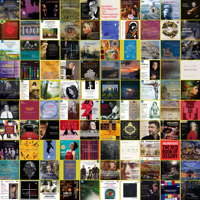 UPDATES: There's a new feature every day at Classical Music Daily. Read about the various ways we can keep in touch with you about what's happening here.
UPDATES: There's a new feature every day at Classical Music Daily. Read about the various ways we can keep in touch with you about what's happening here.
- Antonín Dvořák
- Verdi: Macbeth
- Dieter Schnebel
- Bacarisse
- András Ligeti
- David Hill
- New South Wales
- Emma Griffin
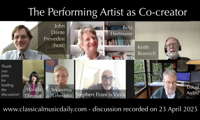 DISCUSSION: What is a work? John Dante Prevedini leads a discussion about The performing artist as co-creator, including contributions from Halida Dinova, Yekaterina Lebedeva, Béla Hartmann, David Arditti and Stephen Francis Vasta.
DISCUSSION: What is a work? John Dante Prevedini leads a discussion about The performing artist as co-creator, including contributions from Halida Dinova, Yekaterina Lebedeva, Béla Hartmann, David Arditti and Stephen Francis Vasta.
Paul Zicheng Fu: A Life in Music

GORDON ANDREW R investigates a Chinese-born composer who has settled in Canada
Born in China in 1928 Paul Z Fu grew up near one of the European concessions where his father owned and operated a photography business. The son took up his father's creativity, but in sound rather than sight and was soon studying Western Classical music with two important émigrés to China who escaped the cultural carnage of Nazi Germany.
He studied with Ernst Weißler and Arthur Schierch. Paul Fu recalls that Weißler (who had sung at Bayreuth) played and sang large segments of Wagner operas from memory. (For further information about Ernst Weißler see: https://www.lexm.uni-hamburg.de/object/lexm_lexmperson_00002477 in German with photo.) (Of Arthur Schierch searching has found little on-line information.)
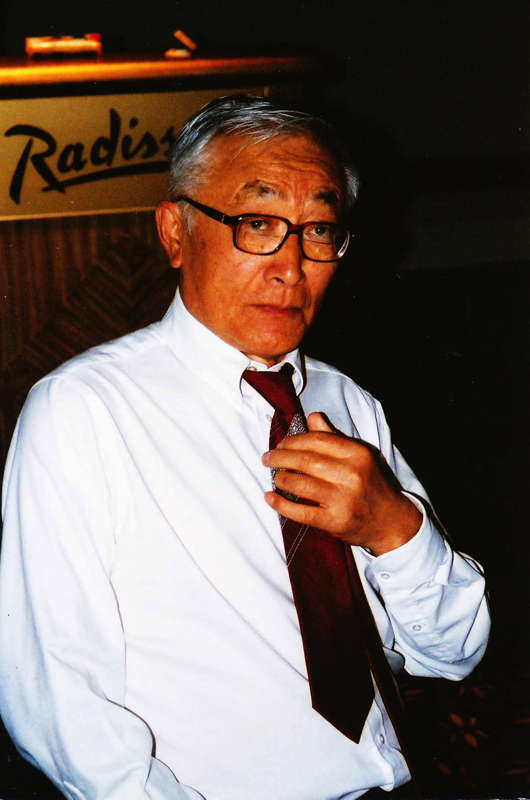
Paul Z Fu in Buffalo in 1989, from the composer's collection. Photographer unknown.
Under their guidance Paul Fu acquired a firm and detailed understanding of Western Music from experienced and knowledgeable musicians.
He studied piano, voice, composition and music theory and soon reached a very high level of achievement. His first surviving composition is from 1947 and is a lovely gem of Romantic musical manner.
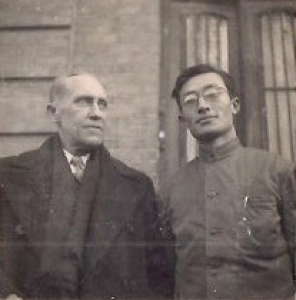
Paul Fu and Arthur Schierch, circa late 1940s, from the composer's collection. Photographer unknown.
Through the 1950s Fu improved his professional situation (beginning as an accompanist at the Central Song and Dance Troupe in Beijing). He eventually became Professor of Music at Beijing Teacher's College – a post he held until he left China. In the course of his academic career he taught piano, theory and composition. He also translated material from English and wrote four textbooks.
The situation changed in the 1960s and Professor Fu spent most of his energies upon teaching music theory. One project that was encouraged was the collection of folk songs, and the result of Fu's field work in Xiang Xi, an autonomous prefecture of the People's Republic of China located in Hunan province, is a cycle of folk songs for voice and piano.
By a complex combination of circumstances Paul Fu left China in 1988 and arrived in North America. His daughter had preceded him and she joined the Montreal Symphony Orchestra. His son arrived too and took up the profession of Piano Technician, while also directing a Chinese choir and composing.
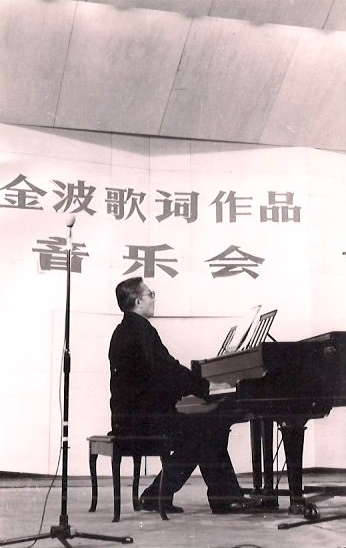
Paul Z Fu performing in China, from the composer's collection. Date and photographer unknown.
Soon after his arrival in North America Paul Fu's works were given a special performance at the State University of New York at Buffalo. The performers included Allen Sigel, clarinet; Gary Burgess, tenor; Wu Long, piano; Sally Martin violin; Chii-Yu Yang, cello. The compositions performed included the Piano Sonata (1981), the song cycle In the Woods and the Rondo (1989). This program also included The Herder's Donkey - Theme and Variations for Clarinet and Piano. The author has not seen this composition.
Paul Fu settled in Calgary, Alberta where he taught piano, music theory and composition privately and he was an important member of its large Chinese community. Always eager to learn more, he entered a composition program at the University of Calgary where he studied with William Jordan, Allan Bell and David Eagle. In 1994 he received his Master's degree. His merit as composer was clearly evident and he is now an Associate Composer of the Canadian Music Centre.
His degree composition was the Second String Quartet (with detailed analysis completed, submitted and approved in 1994).
Most evidently, Paul Z Fu's String Quartet is a powerful and potent work which traverses the world in sadness and suffering, and finally whispers the word 'Hope'.
It has been performed but once and a recording of it is not available for use here. A computer rendition might have given some flavour of the music, but please tell me how a computer can express the anguish, despair and aspiration of such a work? I will tell you that a computer can not. What is required is a fine string quartet of like minds, who know how to study music and not merely sight read it, and who take seriously the import of the music's meaning.
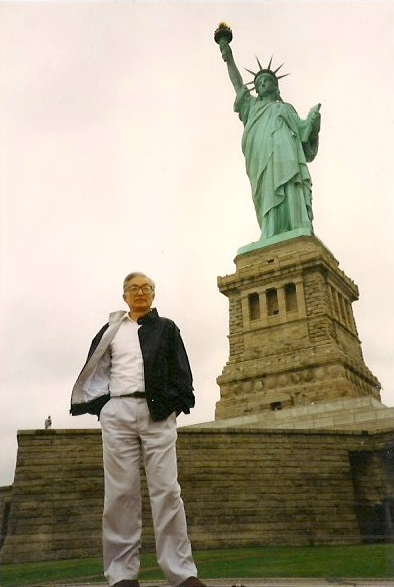
Paul Fu at the Statue of Liberty in New York. Date probably pre-2000. Photographer unknown.
The quartet is in three movements: i) Adagio doloroso, ii) Moderato elegante and iii) Allegro con fuoco.
Interestingly, the programme for the first performance gives these as titles for the movements:
String Quartet No 2 (1993)
Adagio, self confidence in constrained predicament
Moderato, Faramita-breeze from afar
Allegro, victory of consciousness
Performed by the Beau Quartet
Steve Bryant, violin, Sheldon Nadler, violin; Sue Jane Bryant, viola, Peter Parthun, cello
March, 20, 1994
In the accompanying analytical text in his thesis Paul Fu explains the motivic basis of his composition:
In planning this piece, a series of small motives were written out which determined my train of thought. For reference I have given them names: 1) the three note motive, 2) the chorale motive, 3) the motive of Liberty, and 4) the essential motive.
As befits someone of his background the work is carefully constructed and these germinal motives pervade the texture.
The first movement is dark and sonorous, in a web of sound and with continuous melodic and harmonic progress. The music builds to a powerful climax, collapses and then builds again. After a moment's silence the second motive, the chorale, enters in a hymn like manner with repetitions and developments of the melody. But, the doloroso mood returns, though faster now and while building to a great climax, the hymn tune seems to hover over the sound – until all collapses again in quiet and pained muttering.
The second movement is given the tempo direction of Moderato elegante. How could anything be elegant in a frenzied time? The music begins with a high pitched whistle and then a flowing murmuring when a wide ranging cello melody rises from the depths. The music turns to an almost waltz-like lilt in parallel chords and then begins a complex exchange of cello theme (moved into other voices), river like murmuring and high pitched whistle. It seems to me (though Professor Fu disavows this interpretation, not being a follower of Taoism) that the murmuring represents the flow of water and a connection with the Taoist notion of the strength of water and its power to go around and beyond difficulty.
The final movement begins with a strong and motoric idea and eventually reveals itself to be a sonata-form movement. The high point of tension is reached in sections where the whole quartet plays vicious down bows at speed and with fury. It is a vast personal struggle which returns to the anguished music of the opening Adagio doloroso with its forlorn melody and eventual buzzingly dissonant cadence.
This is music that tells a story, but a story of mental activity and suffering - plus, hope and aspiration.
One aspect that I have not considered out of respect for Professor Fu are his deeply held religious beliefs and the importance of the Roman Catholic faith to his mind and his heart. How his religious belief inspires his music I leave in silence.
Professor Fu's compositional output has been small because his works have been carefully crafted and patiently considered.
There is a large song cycle on Chinese texts, a set of choral works for women's voices, a short work for chamber ensemble, numerous piano works — and especially the large scale and powerful Sonata and Suite for Piano.
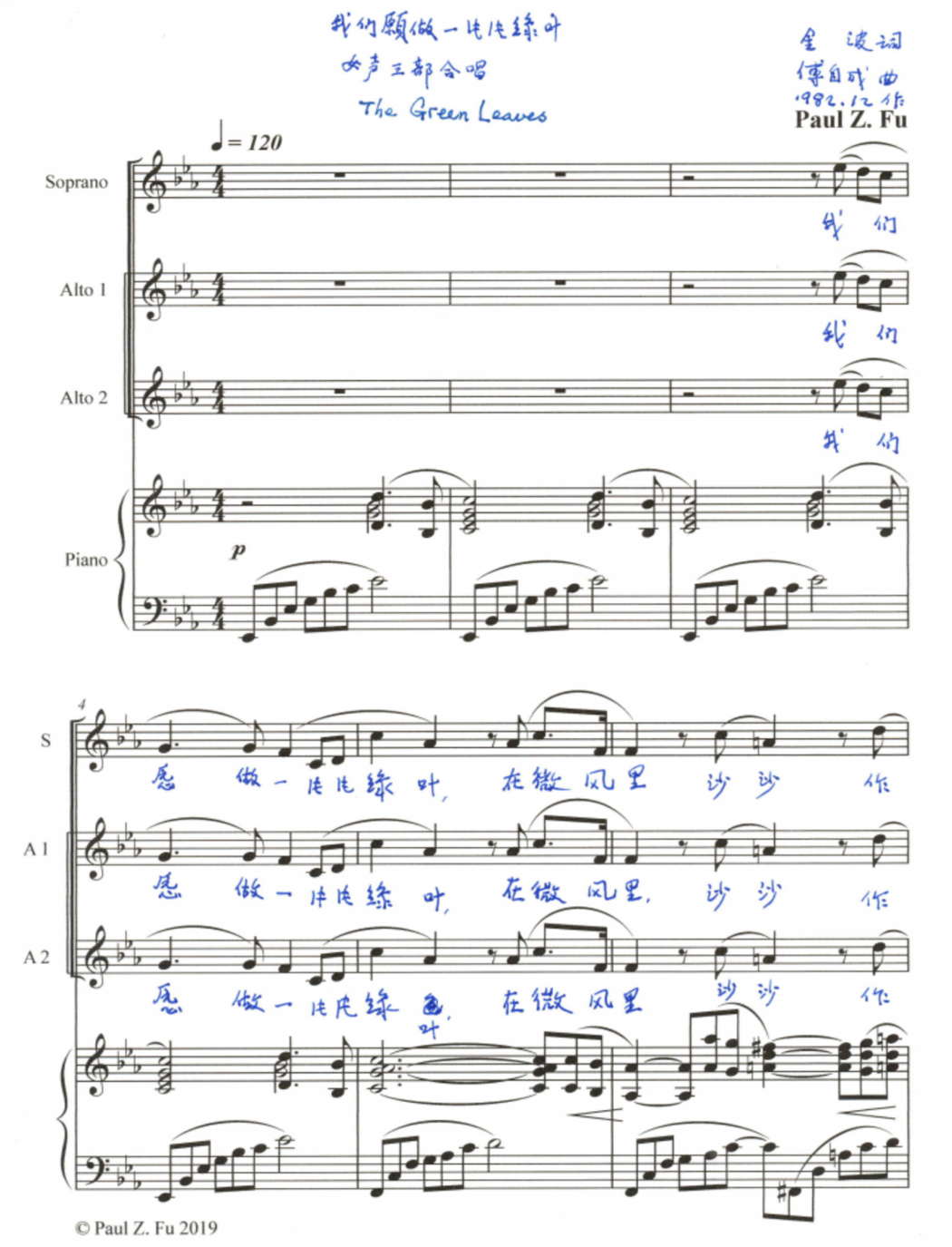
Green Leaves for SAA and piano. With the composer's own meticulous Chinese script. © 2021 Paul Z Fu
One of the most precious of his possessions is the manuscript book in which he has written many of his compositions – with sketches, transcriptions working scores and pristine copies. Fortunately, Professor Fu has allowed this book to be digitized (by Peter Moller of EggPress, Calgary) and as soon as circumstances permit it will be available for research and viewing online.
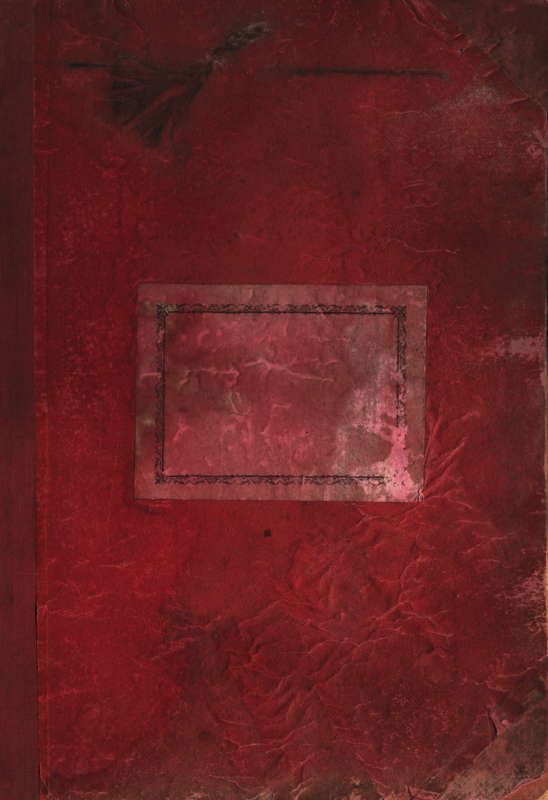
The cover of Paul Z Fu's composing notebook. Digital scan by Peter Moller, EggPress. © 2021 Paul Z Fu
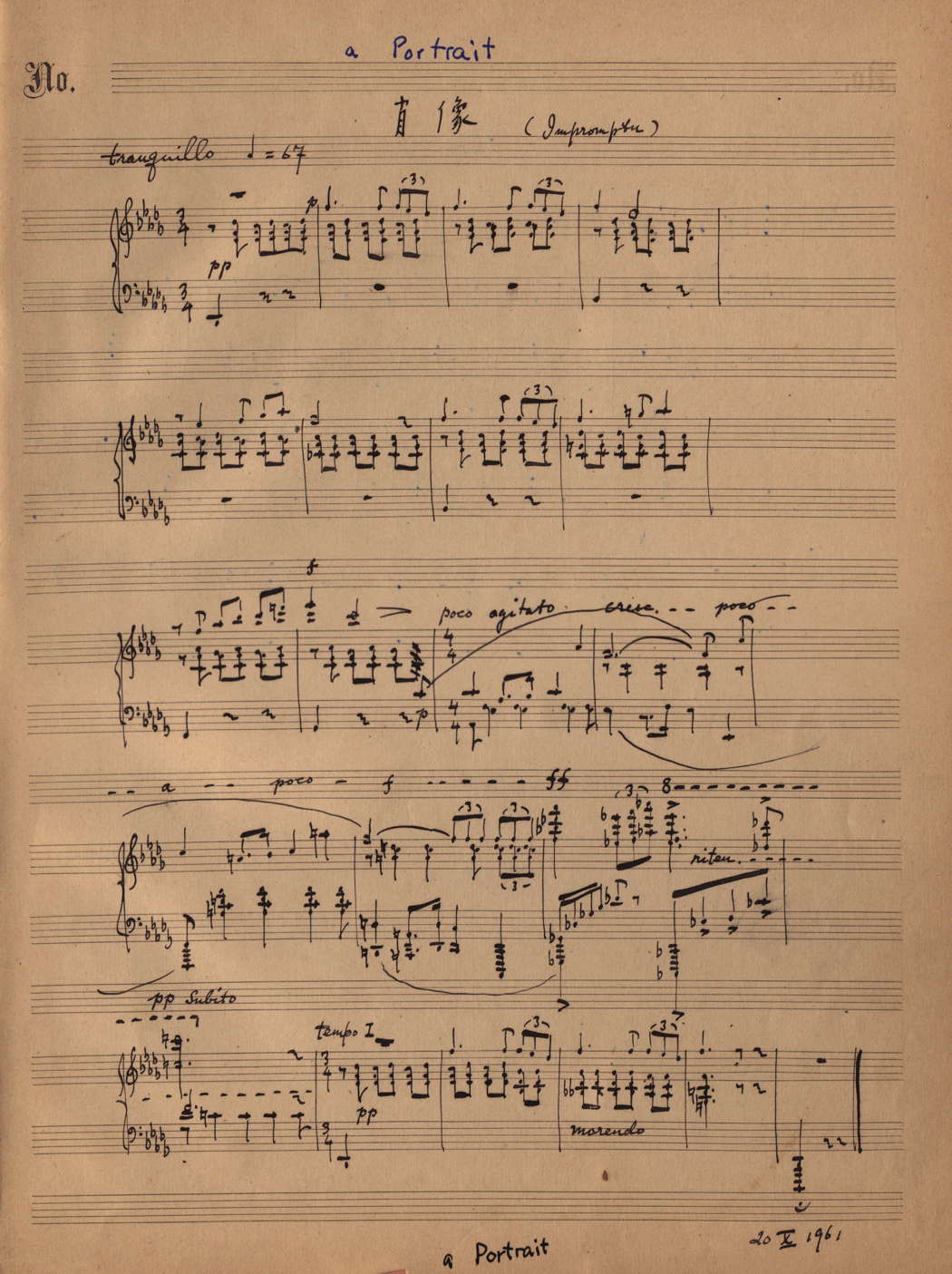
Portrait (1961) from Paul Z Fu's composing notebook. Digital scan by Peter Moller, EggPress. © 2021 Paul Z Fu
The works of Paul Z Fu deserve performance, recording and the awareness of the public. I encourage musicians to investigate these compositions and discover the sincere depth of meaning that they possess. Professor Fu has spoken truly and with honest conviction.
Copyright © 11 June 2021
Gordon Andrew R,
Canada

MORE ARTICLES ABOUT CONTEMPORARY MUSIC
FURTHER INTERVIEWS, PROFILES AND TRIBUTES


